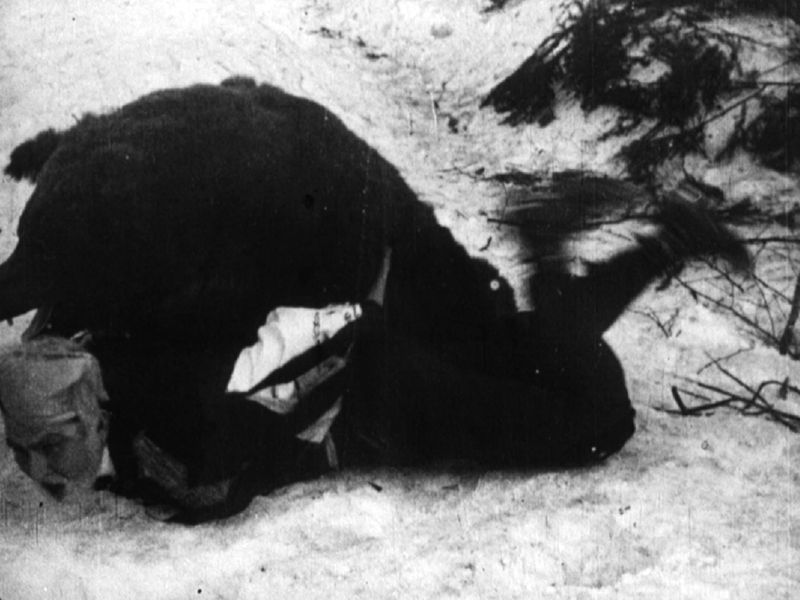KARUJAHT PÄRNUMAAL
[Bear Hunt in Pärnu County]
Tõnis Nõmmits? Johannes Pääsuke? (Livonia, RU 1914)
Although Karujaht Pärnumaal (Bear Hunt in Pärnu County) was made after Laenatud naene, it’s generally considered the first Estonian narrative film, owing to the local origins of the filmmakers and production company. It’s also the first Estonian political satire, based on the conflict between the mayor of Pärnu, a small city on the southern coast, and the journalist Jaan Karu (“karu” is Estonian for “bear”). While there is a humorous bear hunt in the movie – have no fear, no animals were harmed – the “hunt” of the title more aptly refers to Karu.
Mayor Frakmann (looking very much like the real mayor, Oskar Brackmann) reads in the newspaper that a large bear is terrorizing the local German population. The police (who could be cousins of the Keystone Kops), are dispatched to deal with the troublesome creature, together with a posse whipped up by Frakmann. A battle ensues (the bear is clearly a man in a bear costume), but all come away bested by the beast.
Since the late medieval era, Baltic Germans constituted the ruling class in the region, but with the rise of national self-determination in the 19th century, ethnic Estonians sought to change the balance of power. This is the essential background to Karujaht Pärnumaal. More specifically, in 1913, journalist Jaan Karu wrote an article accusing Oskar Brackmann of receiving kickback payments from the Waldhof wood-pulp factory in order to suppress reports about dangerous levels of pollution. The mayor sued Karu for slander and won the case, but lost any moral victory; three weeks later, the Estonian party won majority seats on the Pärnu City Council, and while Brackmann remained mayor until 1915 (and again in 1918-19), the long-standing hold of the German party on Pärnu politics was coming to an end.
An article by Karl August Hindrey published in the Pärnu Postimees in December 1913 made the pun about a bear hunt, clearly referring to Karu, and it was this piece that inspired Johannes Pääsuke (see the note on Retk läbi Setumaa) and cinema owner Aleksander Tippo to satirize the situation on film. Whom to credit as director, however, remains problematic; in a 1935 interview, Tõnis Nõmmits (1881-1950), a theatre hairdresser, wigmaker, and make-up artist, claims to have been the director, though some credit Pääsuke, who was certainly the cameraman. Filming of this admittedly rudimentary short was done not in Pärnu, but in the interior town of Tartu and the Vasula forest just north of the city. Unsurprisingly, the Pärnu authorities were less than pleased: Hindrey reported that the film was partly censored before its Tartu premiere, and the Pärnu police chief banned it outright, though it’s known there were clandestine screenings. Tippo claimed it was even sold for release in St. Petersburg, but the War prevented the deal from being realized.
The current print is derived from a digitized 1976 dupe positive (with some image loss compared to the original) made from a nitrate dupe negative and then transferred to polyester stock. The nitrate elements – a print (317 m.) and a dupe negative generated from the print (320 m.) – were unfortunately disposed of in the 1980s.
Maria Mang


regia/dir: Tõnis Nõmmits? Johannes Pääsuke?
scen: Aleksander Tippo.
photog: Johannes Pääsuke.
scg/des: Tõnis Nõmmits.
prod: Aleksander Tippo, Estonia-Film.
uscita/rel: 13.02.1914 (Cinema Ideal, Tartu).
copia/copy: 35mm, 326 m., 13′ (22 fps); did./titles: EST.
fonte/source: Eesti Rahvusarhiivi Filmiarhiivi, Tallinn.




